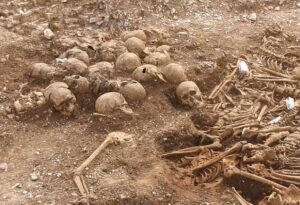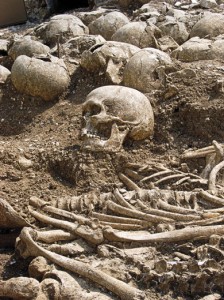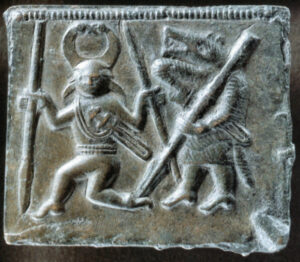We all know what a Viking is: a bare-breasted colossal man of Nordic descent with long flaxen hair, plaited beard and suffering from hirsutism. Added to this should be his filed teeth, perhaps coloured blue, which he bares in a ferocious grin, while banging his mighty sword on his round red-painted shield decorated with fiery dragons. Oh, yes and I nearly forgot his helmet with its horns…
Free fantasy, most scholars will claim! And they are right: we don’t actually know what a typical Viking looked like, when he jumped from his ship in the 10th century, perhaps ready to pillage and conquer a peaceful English countryside.
Physical stature
But we do in fact know something about a group of Vikings, which were executed en masse in the beginning of the first millennium near Ridgewell Hill [1]. And step-by-step we are getting closer to an actual physical sense of these people.
 The men, representing up to 54 individuals, had been summarily executed between AD 970 -1025 by their captors, using swords to hack off their heads. Often this had been done in a messy way and defence wounds were found in a number of instances. One man had probably tried to catch the sword with his hands, which had been cut off. Perhaps the men were naked when executed. At least no remains of clothing, jewellery or weapons were found in the grave, into which they had been brutally slung soon after the execution.
The men, representing up to 54 individuals, had been summarily executed between AD 970 -1025 by their captors, using swords to hack off their heads. Often this had been done in a messy way and defence wounds were found in a number of instances. One man had probably tried to catch the sword with his hands, which had been cut off. Perhaps the men were naked when executed. At least no remains of clothing, jewellery or weapons were found in the grave, into which they had been brutally slung soon after the execution.
Chemical analysis of their teeth later suggested that none of the men was from Britain, but originated in the Arctic or sub-arctic regions of Scandinavia.
Examinations of the bones indicated that most men were 18 to 25 years old, with the youngest in his mid-teens, while the oldest man was over 50. Curiously enough, many of the individuals had suffered from infections and physical impairments; at the same time, there were not many signs of prior war wounds on the skeletons. One man, in particular, must have suffered excessive pain due to osteomyelitis, a chronic bone infection – involving his thighbone. This bone was twice the size of a normal thighbone and had openings, which would have oozed smelly pus during his life.
Other individuals had suspected brucellocis, a highly contagious infectious disease that is passed from animals to humans, either by the ingestion of unsterilised milk or meat or by coming into close contact with secretions from infected animals. It causes a series of chronic symptoms associated with cronic diarrhea, arthralgia and myalgia but also impaired vision, arthritis and anaemia. It can be highly debilitating. All this pointed to the group of men being no more than peasants.

However, several of the individuals had had their teeth filed in order to be able to parade a groovy grin with painted rills, definitely associated with adult males identified as warriors. More than 90 similar filings have been found on Scandinavian skeletons in the last decade, dating from 750 – 1100 [2]. All stemmed from adult men, some of which were associated with weapons and violence. However, the later examples from the city of Sigtuna were found in cemeteries with less prestigious burials. (Might this be the result of a fashion petering out at this late stage amongst the peasants?)
The remains of the men from Ridgewell are currently exhibited in London at the British Museum as part of the Viking exhibition. Here they are presented as Viking warriors, perhaps executed in Dorset after an unsuccessful raid. However, were they really warriors? Or just a sorry bunch of Scandinavian immigrants caught up in the ethnic cleansing on St. Brice’s Day in 1002?
This has been claimed as the most likely explanation behind the execution or brutal slaughter of another group of skeletons found in 2008 at St. Johns College in Oxford [3]. This burial contained the remains of up to 37 males, 16 – 25 years old plus two undetermined youngsters. These skeletons carried a lot of perimortem wounds many consistent with having been inflicted to the back, possibly during flight. Some of the bones had been charred by fire. This caused the archaeologists to (tentatively) identify the dead individuals as victims of the St. Brice’s Massacre 13th November 1002, known from the Anglo-Saxon Chronicle and a charter dated to the 7th of December 1004 in which King Aethelred the Unready granted means for the rebuilding of St. Frideswide’s church in Oxford, which had been destroyed in the uprising. In the charter it says:
‘For it is fully agreed that to all dwelling in this country it will be known that, since a decree was sent out by me with the counsel of my leading men and magnates, to the effect that all the Danes who had sprung up in this island, sprouting like cockle amongst the wheat, were to be destroyed by most just extermination, and thus this decree was put into effect even as far as death, those Danes who dwelt in the afore-mentioned town, striving to escape death, entered the sanctuary of Christ, having broken by force the doors and bolts, and resolved to make refuge and defence for themselves therein against the people of the town and the suburbs; but when all the people in pursuit strove, forced by necessity, to drive them out, and could not, they set fire to the planks and burnt, as it seems, this church with its ornaments and its books. Afterwards, with God’s aid, it was renewed by me’. (Anglo-Saxon Charter S909 as quoted in [3] p. 83 – 84)
As well as the group from Ridgewell, the skeletons found at St. Johns were submitted to a detailed isotopic analysis of the bones as well as the dental enamel. However, the results of these studies were more ambiguous. The diet seems to have been more “Scandinavian” (more fish) and the dental enamel might indicate childhoods spent in Scandinavia. But only just so! Added to this should be the radiocarbon determination, which indicates a date somewhat earlier than the events in 1002 pointing to an earlier event for the massacre. However, this is counterbalanced by the “fish-diet”, which the skeletons witnessed to and which tends to shift the radiocarbon-dating somewhat back in time. Anyway, anyone who has worked with this technique, knows its limitations, when it comes to exact dating. The scientists publishing the results are careful not to conclude more than tentatively.
However, there is more evidence: these men were carrying healed wounds inflicted upon them at an earlier time; further they were robust and taller than average. Hence – probably – real “Vikings” were found at St. John’s College. And, yes: the people from the mass-grave in St. Johns may indeed have been (some of) the victims of the massacre of St. Brice’s. Nevertheless, it is the slaughtered peasants from Ridgwell Hill, which have been promoted in the current (2014) exhibition in London, Vikings – Life and Legend.
Wild and Ferocious Berserks
Bare-breasted and suffering from hirsutism? Most scholars believe this myth was fostered by the legend of the berserkers as documented in skaldic verses, art and other texts.
The central text here is, of course, the description of the berserkir in Haraldskvæði, a skaldic poem believed to be composed in the late 9th century in honour of Harold Finehair by the Norwegian skald, Þorbjörn Hornklofi. Berserkir are mention three times in the poem. Here are verses 20 – 21: [4]
At berserkja reiðu vilk spyrja,
bergir hræsævar,
hversu es fengit
þeims í folk vaða
vígdjǫrfum verum?
Ulfheðnar heita,
þeirs í orrostum
blóðgar randir bera;
vigrar rjóða,
es til vígs koma;
þeim’s þar sýst saman;
áræðismǫnnum einum
hykk þar undir felisk
skyli sá enn skilvísi,
þeim’s í skjǫld hǫggva
A translation might go something like this:
I’ll ask of the berserks, you tasters of blood,
Those intrepid heroes, how are they treated,
Those who wade out into battle?
Wolf-skinned they are called. In battle
They bear bloody shields.
Red with blood are their spears when they come to fight.
They form a closed group.
The prince in his wisdom puts trust in such men
Who hack through enemy shields

Of special interest in this connection is, of course, the etymology of the word berserks – ON berserkr. Did it refer to men fighting naked [berr] or dressed in the skin of a bear [*ber-]? According to Snorri Sturluson (writing 300 years later), they fought naked, but scholarly disputes have raged since the 1860s as to whether they were rather dressed in the skins of animals (bears and wolfs, hence wolf-skinned or Ulfheðnar). Whatever their dress, it seems they were bent on what even today is considered going berserks, fara berserkir, a wild, uncontrollable act of violence perhaps induced by drugs and often described as a state of mind, where the man is possessed by a wild animal; hence the connection between being a beserkr and being shape-shifted.
In a recent magisterial dissertation, Vincent Samsom has presented a state-of-the-art overview of “Les Berserkir”, which he (with Dumézil) calls Les Guerriers-Fauves (the feral fighters). In this work, he does not limit himself to an analysis of the well-known texts from the Icelandic corpus. He also presents the archaeological and art-historical evidence – metal objects, animal masques and runic epigraphy.

His conclusion is that the berserkr’s were known from early migration period, from the 5th to the 7th century, as witnessed by the metallic matrixes from Torslunda on Öland, the plates from the helmet from Sutton Hoo ans Valsgärde, the relief from the scabbard from Gutenstein and the procession shown on the tapestry from Oseberg. (All shown here). Added to this should be the archaeological finds of filted masks from the harbour of Haithabau.
Or perhaps, as is described in the story about the battle at Stiklestad in 1030, where Snorri tells us about a certain þórir hundr (Thorir the dog) who led an army of largely pagan peasants. Amongst these þórir chose eleven companions, who were outfitted in magical coats of reindeer-skin, making them invincible to all weapons. Samsom considers this the last stand of the berserks. Further, it is his conclusion that the phenomena can only be understood as part of the elite culture connected to the concept of comitatus (Tacitus), trustis (Merovingian) or gefolgschaft (Germanic).
Horns
The observant reader has already detected one more interesting feature about the dancing Berserkr in the die from Torslunda: he is wearing a helmet with horns.
There is no doubt that Vikings carried helmets, but only three have so far been found. And only one of these is less than fragmentary: the Gjermundbu helmet from Norway, which was found in a chieftain’s grave and which has been dated to AD 970. This helmet is one of the absolute highlights in the present Viking-exhibition in British Museum 2014. It was found together with 85 fragments of a chain mail shirt, a sword decorated in Jelling-style, two spearheads, two axes, fragments of four shield bosses, two stirrups, two spurs, five bridles, eight arrowheads, other riding gear plus a rattle, fish hooks, a pair of sheers, knives a tinder-box and metal buckles from a belt. The artefacts in the grave were found packed in an iron kettle next to the cremated remnants.

This unique find of a helmet has made most archaeologists speculate that the helmets of the Vikings were probably more often than not made of leather and thus perished in the excavated Viking-burials. Another explanation, however, might be that helmets were precious heirlooms and passed on to the descendants of the dead warrior. Whatever the explanation nearly half of all illustrations on picture-stones do show Vikings with helmet. However, only very early depictions of Northmen, show them with horns attached, as is the case on the Torslund matrix from 600 AD
However, there is one illustration of impeccable Viking-pedigree, which shows a horned helmet: The Oseberg tapestry from around AD 834, of which fragments were found in the famous boat-grave and which are now exhibited at Bygdøy in Oslo. These fragments are believed to show a religious ceremonial procession. One of the participants, dressed in a tight-fitting tunic and baggy trousers is holding a sword in his left hand and carries a horned helmet!
Normally this man is interpreted as a shaman leading a religious procession, but who really knows? Perhaps he really was a Viking going berserk? Perhaps Vikings occasionally did wear helmets with horns?
Fascination
Without doubt, there is a lot we shall never know about the Northmen who played such a dominant role in 9th – 11th century Europe. However, little by little careful exploration of old evidence and archaeological excavations of new sites grant us a better understanding of the life and legends of these enigmatic people, who succeeded in carving out a new world for themselves in the Northern hemisphere.
Hopefully, in the same process, we will learn to appreciate that they were not always ferocious fighters, nor necessarily heathens and seldom just pirates bent on pillaging.
However, one aspect is left which set them apart: their mighty ships.
Or mutatis mutandi: 80.000 soldiers, 270 tanks, 180 armoured vehicles, 90 helicopters, 380 artillery pieces, 140 military aircrafts, 19 ships!
SOURCES
[1] ‘Given to the Ground’: A Viking Age Mass Grave on Ridgeway Hill, Weymouth
By Louise Loe (Author); Angela Boyle (Author); Helen Webb (Author); David Score (Author)
Oxford Archaeology 2014
Series: Dorset Natural History and Archaeological Society, Vol. 22
ISBN: 9780900341588
[2] Spatial and Temporal Trends in New Cases of Men with Modified Teeth from Sweden (ad 750–1100).
By Anna Kjellström. In: European Journal of Archaeology, Vol. 17, Issue 1 (February 2014), pp.45 – 59 –
[3] ‘Sprouting like Cockle amongst the Wheat’: The St. Brice’s Day Massacre and the Isotopic Analysis of Human Bones from St. John’s College, Oxford.
By Pollard, A. M. et al.
In: Oxford Journal of Archaeology 2012 Vol. 31 (1) p. 83 – 102.
[4] The ON text is From: Heimskringla.no . The translation is from Chronicles of the Vikings.
By R. I Page
Toronto, Canada: University of Toronto Press. p. 109.
ISBN 978-0-8020-7165-1.
(A more recent edition and translation may be found in Poetry from the Kings’ Sagas 1. By D. Whaley. Brepols 2012. ) See also the edition rendered at the website: Scaldic Poetry of the Scandinavian Middle Ages.
[5] Les Berserkir. Les guerriers-fauves dans la Scandinavie ancienne, de l’Âge de Vendel aux Vikings (Vie – Xie siècle).
By Vincent Samson
Villeneuve-d’Ascq, Presses Universitaires du Septentrion, 2011.
(Recently published this is a good place to start when trying to get a grip on this very long academic discussion).
READ MORE